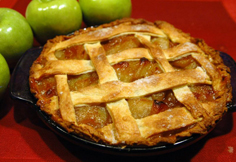Morse appendix
by Roger J. Cooke, G3LDI (GB2CW Co-ordinator)
 Morse and Apple Pie
Morse and Apple Pie
Learning Morse is much like apple pie. Let me explain. Most people like apple pie, but some like it with stewed apple, some with chunky apple. Some like short-crust pastry, others like puff pastry. Some like added sultanas, others like added cloves. (I cannot stand those!) Some like apple pie with custard, others with ice cream and yet others like double cream. Morse is much like that. There are numerous methods of learning the Code, and it is a personal choice as to what method you use. No written rules can be made, but some guidelines can be suggested and the method that suits the individual is then the correct one for THAT individual.
Raw Beginners
For receiving practice, you have to rely on a ham radio operator who can send/generate Morse code using an oscillator or you can try to find out Morse code transmissions over your radio receiver, such as the GB2CW transmissions. Morse code practice cassettes and multimedia computer software are nowadays available. Remembering the Morse code is an art form by itself. It involves a rhythmic response in your mind. Try to remember the combination of dot (.) and dashes (-) by their sound and not as a group of printed symbols. For this purpose, a dot (.) is referred to as a ‘di’ and a dash (-) as a ‘dah’. A ‘di’ coming at the end of the combination is pronounced as ‘dit’
Tutors have their own methods and I will describe mine. These are not definitive by any means but will provide a starting point. When I start with a new class, I usually start with a couple of letters, and ask the students to repeat the code in dit-dah fashion. Di-dah would therefore be A. I then add another letter, and ask them to repeat them, alternating in uneven sequence until they can have an instantaneous response. Then I send to them on the oscillator, with a keying speed of 20 wpm. This method can be repeated with additional letters being added as we progress. I then send them via e-mail a print out of the complete code, letters, numbers and punctuation, with the usual pro-signs and Q codes that are used in everyday communication.
Other tutors might have other ideas. I then advise what to do at home with regular practice each day.
Home Practice
Home practice can take the form of learning of the complete code, using various methods.
- Try to engage the help of somebody calling out characters and transpose them into Morse. This can also be done in reverse, using the dit-dah format.
- Cut some squares of cardboard, an inch square, with a character on one side and the equivalent in Morse on the other. Put them in one pocket and take out one at a time at random. Again, translate from one to the other.
- As you do other things, translate occasional words and numbers that you see into Morse.
- Listen to the local GB2CW SLOW Morse broadcasts that you might have in your area. You can find the details on the GB2CW Broadcast schedule.
These methods will enable the raw beginner to commit to memory most of the code. It is not an overnight achievement so have patience. You should commit to at least 20 minutes each evening, preferably 30 minutes, but whatever you can spare. This practice has to be constant. Leave it for a week and you will not improve. There will be characters that become stumbling blocks, X, Y, Z, Q etc These are letters with the largest amount of bits, purely because they are the least used. However, they must be as easily recognized as the letter E.
Farnsworth or Koch?
Both methods are good and in fact can be used simultaneously. I have always taught using the Farnsworth method. This entails learning the complete code all at once and committing it all to memory. When starting to receive Morse, there might be a bit more thinking time, but it does not matter. This thinking time will gradually decrease with constant practice. A good tutor will always stay a few steps ahead of your ability to copy 100%. If this were not the case, there would be no progress.
The Koch method requires the student to learn 2 or 3 characters and then practice with these at 20 wpm. Obviously thinking time will be less as there are only 2 or 3 characters to choose from! Adding another character then builds up the speed. However, I feel that this takes a longer time to learn and does not necessarily keep all the students at the same level. This will always be a problem due to varying practice times.
Computer programs
There are numerous computer programs that can be used with Morse practice and they can be set up to suit each individual’s needs. Teach, by ZL1AN, and Learning Morse by AA9PW are two very good ones for beginners. However, there are numerous others and a Google search of the internet will produce loads of them. Try them all, as all practice is good practice.
Listening on the bands
This is where the really exciting part helps. Listen to the latest DX-pedition and see how many calls you can copy. Try copying his at first. It may take several attempts as they normally send around 30 wpm. However, with perseverance and patience and practice, you will soon be successful. The three P’s are very important in this respect, so don’t despair at the first attempt.
The pleasure that you will obtain by being able to use CW at a reasonable speed, finding new contacts and making new friends will outweigh the effort that you had to put in to becoming a proficient CW operator. Remember, Winners never quit but Quitters never win.











